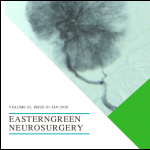Outcome of Endoscopic third Ventriculostomy for Obstructive Hydrocephalus due to Posterior Fossa Lesions
DOI:
https://doi.org/10.3126/egn.v2i1.27453Keywords:
ETV, Endoscopic third ventriculostomy, Posterior Fossa TumorAbstract
Background and purpose: Obstructive hydrocephalus can be treated with External ventricular Drainage (ETV), Ventriculo peritoneal shunt insertion, upfront tumor removal without cerebrospinal fluid diversion procedures or more recently ETV. Aim of our study was to study the outcome of ETV in treating such patients.
Material and method: Descriptive observational study conducted at Upendra Devkota Memorial Institute Of Neurological and Allied Sciences from Sep 2015 to may 2017.
Result: Twenty-three patients met the inclusion criteria. Among which, 14 (39%) patients were male with male to female ratio of 1.55. We included wide age range from 3 years to 68 years. Seven patients (30.4%) were less than 10 years while 6 patients (23%) were above 60 years old. Patients with Posterior fossa presented with varied symptoms. Ten patients (43.4%) presented with decreased level of consciousness, 14 (60.8%) presented with visual symptoms, 17 (73.9%) presented with vomiting and 23 (100%) presented with headache (Figure. 3). Visual acuity was normal among 3 (13%), decreased among 11 (48%) and with no perception of light among 3 (13%). However, acuity was not assessed among 6 (26%) patients (Figure 4).Funduscopic evaluation revealed papilledema among 20 (87%) patients while secondary optic atrophy among 3 (13%) patients. Patients were evaluated in follow up for symptomatic improvement. Consciousness were improved among 8 (80%) patients, visual symptoms improved among 10 (71.4%) patients, vomiting subsided among 15 (88.2%) patients while headache improved among 100%. Following ETV, 5 (21.7%) patients developed complications, 3 (13%) patients had intraventricular bleeding while 2 (8.6%) patients had CSF leakage from the wound.
Conclusion: Endoscopic third ventriculostomy is a relatively safe and valid option for treatment obstructive hydrocephalus due to posterior fossa lesions.




